The gut microbiome decisively affects the development of chronic diseases. In the past decade, our understanding of the complex interaction between the gut ecosystem and health has taken a quantum leap. Alongside this new understanding, hope emerges that treatments based on faeces from healthy donors can be further developed. Both academia and the industrial sector are pursuing this hope, which creates unique opportunities for innovation. This also raises ethical and human rights issues.
Clostridioides (formerly Clostridium) difficile infection is a prime example of a microbiota-driven disease in which terminally ill people recover overnight after receiving donor faeces. In a randomized study published in 2019, we demonstrated how faecal microbiota transplantation (FMT) is far more effective than using vancomycin or fidaxomicin, the most effective marketed antibiotics. Neither new nor original, our findings may help to ensure that this treatment is available to anyone who has recurrent infections.
People have been using faeces in medical treatments for millennia. Written sources from 4th-century China and ancient Egypt describe how human or animal faeces were used to treat all kinds of ailments. In modern times, the American surgeon Ben Eiseman reported in 1958, for the first time, how four seriously ill people with severe intestinal inflammation were cured after receiving rectal infusions of faeces from healthy donors.
The breakthrough for FMT came in 2013, when a Dutch research group published a clinical trial in the New England Journal of Medicine. The trial was stopped prematurely following interim analysis because of its ground-breaking results: 15 of 16 patients who received donor faeces via a tube recovered from recurrent C. difficile infection versus only 7 of 26 who received high-dose antibiotics.
Since then, a further eight randomized trials and a meta-analysis have confirmed that FMT is effective for these patients.
Clinical researchers are now eager to investigate whether donor faeces can be used to treat other conditions such as chronic inflammatory bowel disease, decompensated liver cirrhosis, or carrier status with multidrug-resistant microorganisms. More than 200 clinical trials are underway involving FMT globally, including in Denmark.

The human rights of faecal donors
Using faeces as a treatment puts special demands on logistics and safety. Blood banks have taken good care of their volunteer donors for more than a century, ensuring that voluntary and unpaid donors continue to donate blood, plasma, bone marrow and now also faeces to serve a greater cause. In Denmark, the public blood banks actively participate in developing FMT, making it reliable, scalable and safe within the public healthcare system.
A treatment with an efficacy exceeding 90% and the potential to completely reverse a life-threatening disease could also have significant positive economic benefits. This raises questions about how these economic benefits should be managed and what the market value of such treatment might be. And can voluntarily donated faeces even be marketed commercially?
For instance, what legal rights do the donors have? Can faeces be abused?
Basic human rights ensure that humans and their biological material cannot be commercialized. This principle is embedded in the European Union Tissue and Cells Directive (2004/23/EC) and the corresponding Danish Tissue Act, which regulate all tissue banks, including Denmark’s blood and faeces banks.
The basic principle is described in detail in the Guide to the quality and safety of tissues and cells for human application published by the European Directorate for the Quality of Medicines & HealthCare of the Council of Europe.

Photo: ©Simon Mark Dahl Baunwall
Bacteria as medicine
Once the legal rights are in place, the next question is how to make it happen. Do we produce capsules with high-quality faeces? Will standardized products based on human faeces be marketed commercially?
Minimally processed faeces is a tissue that is processed at tissue centres in Denmark and is used to treat patients. The clinical activity focuses on treating patients with C. difficile, and clinical trials are investigating new indications. Products derived from human faeces, e.g. pure cultures of special microorganisms, enriched concentrates or otherwise standardized products used for treating ill people, may be developed and would meet all requirements for pharmaceuticals and hence have the potential for protected marketing or market exclusivity.
This raises the fundamental question of when gut bacteria goes from being classified as tissue to becoming a drug.
Probiotics are cultured microorganisms that may be ingested to promote health. Probiotics are sold over the counter as food or food supplements and are not accompanied by health claims or instructions for treating specific diseases. Probiotics have been known for more than a century, but the promises of miraculous results remain unfulfilled.
Microorganisms that are used and marketed for defined therapeutic purposes are called live biotherapeutic drugs, and they could also be called next-generation probiotics. One of the first examples of this is the experimental use of specific lactic acid bacteria as a concomitant treatment for involuntary infertility.
The greatest risk
Using donor faeces to treat ill people differs in certain key ways from using probiotics or live biotherapeutic drugs. FMT uses faeces from just one donor, and the sole purpose of processing the faeces is to make it suitable to administer, either via a tube or as capsules.
In Denmark, this takes place at tissue centres in public hospitals, which carry out the entire procedure, from recruiting and screening donors, laboratory processing and storage, treatment, follow-up visits and registering and treating people for any short- or long-term complications.
The risks and benefits of using donor faeces must be taken into account. For people with recurrent C. difficile infection, this trade-off is not controversial because the disease is life-threatening and the effect immense. The only significant risk is that the treatment does not work the first time for 20% of those treated.
However, for people with chronic benign diseases who may need more than one treatment, the situation differs somewhat. Pure cultivated consortia of microorganisms can be used, and this provides the possibility of ex vivo production on an industrial scale.
Yin and yang and the brown gold seam
In the United States, products based on gut microbiota are developed in a delicate balance between academic medical centres offering clinical FMT and investigator-initiated clinical trials versus industrial companies advocating for market exclusivity. This prompted an industry representative to ask the United States Food and Drug Administration to stop academic institutions from using FMT to ensure inclusion in the studies required to apply for market exclusivity. The developments in the European Union should and can take a different and better route.
The United States only has product-oriented legislation that forces all parties to protect their own activities, whereas Europe also has process-oriented legislation in the form of the European Union Tissues and Cells Directive.
A comprehensive monitoring system ensures both the legal rights of voluntary donors and equal and free access to a proven life-saving treatment.
Further, this type of legislation gives researchers and industry in Europe a unique opportunity to be innovative when developing microbiota-based treatments.
Balancing academically based innovation with transparent knowledge sharing and the pursuit of industrial and commercial interests comprises a potential inherent conflict. Nevertheless, this dualism, which has been compared with yin and yang, provides a basis for synergistic innovation.
Parallel or serial innovation processes and research collaborations potentially offer the best chance of finding this gold seam that the contents of the human gut is supposed to be. The many unknown factors in using donor faeces can be explored in small, high-risk projects with transparent knowledge sharing. The technology readiness level for using donor faeces is still so low that it is too early to end the development of patents and market exclusivity. If specific microorganisms with special significance for certain diseases or conditions are demonstrated, these can, in turn, be examined in an industrial context with production in mind. Both approaches benefit patients and society as a whole.
